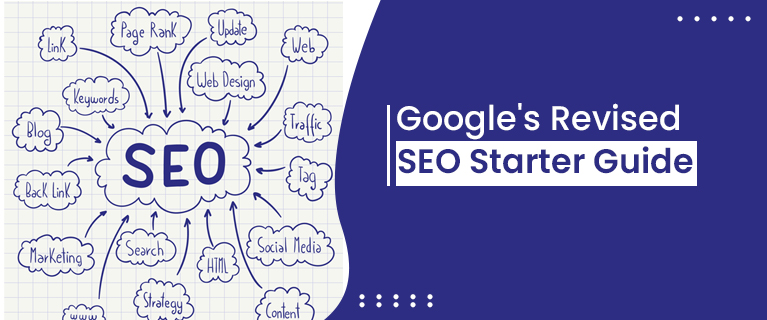Google’s unveiling of the third iteration of its SEO starter guide signals a pivotal shift in how it approaches educating beginners in the realm of search engine optimization. Unlike its predecessors, this latest version represents a significant trimming down, honing in on essential topics vital for individuals just setting foot on their SEO journey.
Read Also This – Beyond Click-Through Rate in PPC Marketing
This streamlined guide reflects Google’s commitment to providing clear, concise, and actionable insights into SEO fundamentals, catering specifically to novices navigating the intricate landscape of online visibility. By distilling complex concepts into digestible nuggets of information, Google aims to demystify SEO and empower beginners to make meaningful strides in improving their website’s search performance.
Evolution of the Guide:
The decision to streamline the guide comes with a deliberate focus on accessibility and usability. Recognizing the overwhelming nature of SEO for newcomers, Google has curated the content to prioritize foundational principles while omitting extraneous details that may overwhelm or confuse beginners. This approach not only facilitates quicker comprehension but also encourages practical implementation of SEO best practices from the outset.
Read Also This – Digital Marketing Success With A Monthly Newsletter Guide
Furthermore, the trimmed-down nature of the guide allows for a more focused exploration of core SEO concepts, ensuring that beginners grasp essential principles without being bogged down by unnecessary complexity. By presenting a curated selection of topics, Google aims to equip novices with the knowledge and confidence needed to embark on their SEO journey with clarity and purpose.
For seasoned SEO professionals, this revamped guide serves as a valuable resource for refreshing foundational knowledge and gaining insights into Google’s current priorities and best practices. By revisiting fundamental concepts through the lens of Google’s latest guidance, seasoned professionals can ensure alignment with current industry standards and refine their strategies accordingly.
Read Also This – A Comprehensive Guide to Mastering YouTube Advertising
The implications of Google’s updated SEO starter guide extend beyond individual practitioners to the broader SEO community and the digital landscape at large. By empowering beginners with accessible and actionable guidance, Google fosters a culture of inclusivity and knowledge-sharing within the SEO community, ultimately contributing to the overall improvement of online content quality and user experience.
In essence, Google’s unveiling of the third iteration of its SEO starter guide marks a strategic evolution in its approach to educating beginners in the field of search engine optimization. Through a focused and streamlined presentation of essential SEO concepts, Google aims to democratize access to SEO knowledge, empowering individuals to unlock the full potential of their online presence in an increasingly competitive digital landscape.
Initially introduced as a PDF document in 2008, the Google SEO Starter Guide has undergone periodic updates, with the last major revision occurring in 2017. However, the latest iteration represents a departure from tradition, with Google opting for a “pocket-sized” version aimed at a starter audience.
Read Also This – Setting Up to Compete with Amazon Through Major U.S. Expansion,” Claims TikTok
Key Changes And Rationale:
1. Glossary Section:
Rationale: Google’s decision to remove the standalone glossary section and integrate individual term explanations directly within the guide stems from a desire to enhance the learning experience for beginners. By contextualizing terms within the relevant sections of the guide, novices can better understand how each term relates to the broader concepts of Search Engine Optimization. This approach eliminates the need for users to constantly refer back and forth between the glossary and the main content, streamlining the learning process and promoting better retention of information.
Implications: Integrating term explanations within the guide not only simplifies the learning experience for beginners but also encourages a deeper understanding of SEO concepts. Novices can now grasp the meaning of terms in the context of real-world examples and practical applications, fostering a more comprehensive understanding of SEO fundamentals.
2. Structured Data Section:
Rationale: Google’s decision to omit the structured data section reflects a recognition of the advanced nature of this topic and the increasing prevalence of content management systems (CMS) with built-in support for structured data markup. By focusing on more foundational SEO concepts, Google ensures that beginners are not overwhelmed by complex technical topics that may be better suited for advanced practitioners.
Implications: While structured data markup remains an important aspect of SEO, its omission from the starter guide allows beginners to focus on mastering fundamental principles before delving into more advanced techniques. This approach ensures that novices build a solid foundation in SEO concepts before tackling more complex topics, thereby enhancing their overall learning experience and skill development.
3. Mobile-Friendliness Section:
Rationale: Google’s decision to exclude a dedicated section on mobile-friendliness reflects the widespread adoption of responsive web design and the integration of mobile-friendly practices into modern website development. With the majority of websites now prioritizing mobile responsiveness, Google deemed it unnecessary to devote a separate section to this topic in the starter guide.
Implications: By not including a dedicated section on mobile-friendliness, Google encourages beginners to prioritize mobile responsiveness as an integral aspect of website design from the outset. This approach reinforces the importance of catering to mobile users and ensures that beginners understand the significance of optimizing their websites for various devices without the need for explicit guidance in the starter guide.
4. Analyzing Site Performance:
Rationale: Google’s decision to exclude a section on analyzing site performance acknowledges the complexity of this topic and the diverse range of tools and techniques available for evaluating website performance. By focusing on fundamental SEO concepts, Google ensures that beginners are not overwhelmed by the intricacies of site performance analysis, which may be better suited for advanced practitioners with more experience in SEO.
Read Also This – Generative AI Show down: Analyzing the Best Performers – ChatGPT, Google Bard, Bing Chat, and Claude
Implications: While analyzing site performance remains essential for optimizing website effectiveness, its exclusion from the starter guide allows beginners to prioritize foundational SEO principles without getting bogged down in technical details. This approach empowers novices to focus on actionable strategies for improving their website’s search visibility and user experience, setting them on the path to success in their SEO journey.
Additions to the Guide:
In addition to pruning certain sections, Google augmented the guide with valuable additions aimed at enhancing clarity and providing context for beginners:
1. Emphasis on “Why”: Google introduced sections addressing why certain SEO practices are essential and why specific topics were omitted from the guide, empowering beginners with a deeper understanding of SEO principles.
2. Expanded Content on Duplicate Content and Videos: Recognizing the significance of these topics, Google included comprehensive explanations on addressing duplicate content issues and optimizing videos for search.
3. Insight into SEO Theories and Timeframes: A new section sheds light on common SEO theories and provides insights into the timeframes required to observe the impact of SEO efforts, offering valuable perspective for beginners navigating the intricacies of search optimization.
Content Compression and Simplification:
In its quest to tailor the guide for novice audiences, Google compressed and simplified various sections:
1. Streamlined Checklists: Sections such as “Are You on Google” and “Do I Need SEO” were condensed into succinct checklists, offering quick reference points for beginners.
2. Shortened Explanations: Google significantly reduced the length of sections like title links and snippets, focusing on concise explanations while providing links to more comprehensive resources for further exploration.
3. Emphasis on Alt Text for Images: With a focus on accessibility and user experience, Google prioritized guidance on alt text for images, recognizing its importance for beginner audiences.
4. Condensed Guidance on Links and Site Structure: While retaining the essential messaging on links and site structure, Google condensed these sections to cater to beginners’ needs without overwhelming them with extraneous details.
Future Outlook:
Google expressed its commitment to maintaining the clarity and relevance of the SEO starter guide, with ongoing efforts to refine documentation and enhance user understanding in the pipeline.
Implications for SEO Practitioners:
For both new entrants and seasoned professionals in the field of SEO, the revised starter guide serves as a valuable resource. Novices can leverage the guide’s streamlined content and clear explanations to build a solid foundation in SEO principles, while experienced practitioners can benefit from updates and insights into Google’s evolving approach to search optimization.
Read Also This – Google Explains Why Useful Links May Not Be So Important
In conclusion, Google’s revamped SEO starter guide represents a significant shift towards catering to the needs of beginner audiences, offering simplified yet comprehensive guidance on fundamental SEO concepts. As the digital landscape continues to evolve, embracing resources like the starter guide ensures that practitioners stay abreast of best practices and adapt effectively to changing algorithms and trends.



